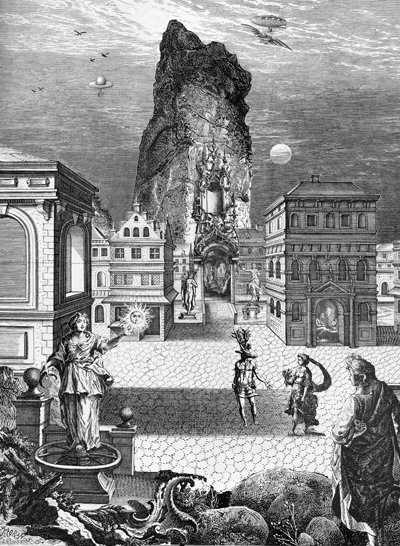
A previous post somewhat prematurely announced the discovery of a number of historical views of the Zymoglyphic region. Many more of these views have since surfaced and are now available in book form from the museum shop. You can also order individual poster size prints, framed or unframed. A generous sampling of the views may be seen here.
These views show the natural history of the area and scenes of daily life in its villages, woods, and jungles, beginning with the wet, humid, lowlands where Rust Age customs still hold sway, moving through the mountainous uplands, and finally entering the buzzing capital city at its center, as well as some of the more remote wonders on the region. Its people are engaged in creative, if often enigmatic, activities, in a landscape of strange and strangely familiar creatures, chimeras, and spirits.
Our resident Scholar Monk has discovered that these supposed documents are but fevered dreams, cobbled together from various European engravings whose sources have been tracked down. Most of them date from northern Europe's Age of Wonder, a world of extravagant architectural excess, grotesquerie, fabulous creatures, wunderkammers, and arcane alchemical investigations. The backgrounds owe much to a 19th century fascination with picturesque landscapes, especially Giovanni Piranesi's Roman ruins and the works of Gustave Dore. Dore's illustrations for Chateaubriand's Atala were used extensively. They imagine a primeval America of eerie dark woods, gnarled old trees, vast rivers, and tropical oases.
Much of the flora, some of the fauna, and even a bit of the architecture in these views was provided by the work of Ernst Haeckel, an artist/scientist noted for detailed depictions of plants and animals as art forms in his book Kunstformen Der Natur (1904).
In addition to numerous volumes in the Dover Pictorial Archive, two online sources have been ransacked for images. PK, a semi-anonymous blogger, has been scouring the world's digitized historical illustrations from his Antipodean outpost for many years, and posting the results at Bibliodyssey. His taste for the eccentric and propensity for high-reolution have been invaluable for this project. Mr. H explored a similar vein in the late Giornale Nuovo blog (2002-2007).
This sort of thing is not unprecedented. Other artists have used collages of old engravings, most notably the surrealist collage novels of Max Ernst, and more recently San Francisco's own Satty. The Ubu Gallery in New York recently had a show of artists who have used 19th century engravings in collage.
No comments:
Post a Comment